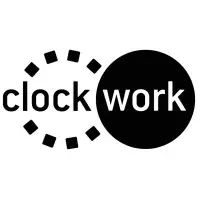How Clockwork Increased their Project Margin with Parallax Insights

About:
Location: Minneapolis, MN
Employees: 55 employees
Company type: Design & technology consultancy
Integrations:
Harvest
Hubspot
Clockwork is an experience design and technology consultancy focused on transforming businesses by focusing on the “why” behind problems to develop performance-based solutions.
While Clockwork has achieved reliable success, they had previously struggled with outdated proprietary software and inconsistent processes. To help solve that, the company today leans on Parallax, in conjunction with Hubspot and Harvest, to keep a close pulse on their project health, resulting in a double digit project margin increase and 35% increase in their resource utilization.
We sat down with Clockwork President, Jenny Holman, to learn more about the impact that Parallax has had on Clockwork’s growth. Specifically, we were interested in uncovering one critical detail: How has Parallax empowered employees, from leadership to front-line resources, to make more informed decisions, dispel assumptions, and work in a way that results in stronger project outcomes.
Here’s what we learned.
Would You Mind Introducing Yourself?
HOLMAN: I’m Jenny Holman, I’m the president of Clockwork. In my role as president, I’m really accountable for ensuring that we bring the right opportunities to the right humans to solve problems.
What Does Clockwork Do?
HOLMAN: The problems that we solve are mostly thinking about how we can bring technology into spaces that create human-centered solutions. That’s a lot of words to mean apps, websites, business applications. But I think the thing that we do a little bit different from others, is that we’re not just building the thing, but we’re also thinking about what has to happen to make the thing successful.
So that looks like change enablement, it looks like product adoption. It’s bringing humans along with the change.
What Problems Did Clockwork Face Before Using Parallax?
HOLMAN: Clockwork grew out of a software development company that was building proprietary tools that we were selling to our clients.
And one of the tools that we had for lots of years was our own proprietary time and billing system that also had some forecasting in it. And as we started looking at where we were really profitable and where we were wanting to really focus our efforts, building and maintaining our own products that we weren’t selling to the world was not one of those things.
And so one of the biggest challenges we had was that we didn’t trust that we could make any enhancements or changes to this platform without it completely destroying everything. Which was very risky. Which also meant that we just didn’t have very good visibility into anything beyond just raw numbers in terms of hours logged and dollars in the door.
[It was] a lot of manual work for us to understand things like margin or where we were making more money on certain types of work and where we were not? So just a lot of overhead, a lot of extra work, a lot of inefficiency.
What Finally Triggered Clockwork to Seek Another Solution?
HOLMAN: That was really the jumping off point, because we were getting to the place where everything that we had built was going to cost us a really significant investment to keep it moving.
And so we knew we needed to move away and find new time management platforms. We were like, how are we going to manage time and billing? And so we started there first, thinking about the foundation. And as we were doing some of that investigation, it was where we started to hear about Parallax and some more of the reporting side of things.
We’ve been using HubSpot for a very long time, and so we knew that was going to stay. But as we started to think about how we connect the dots between systems and how we use that to also influence what’s the right other systems for us to choose, that all came into the criteria for how we were making decisions.
Do You Remember the Other Tools You Had Considered?
HOLMAN: You know what’s funny? I actually don’t remember if we found any other tools that were similar, from a reporting perspective, from an information hub, like Parallax.
Who, at Clockwork, Uses Parallax the Most?
HOLMAN: So I would say right now, the people that are using Parallax most are client strategists, which really serve as our project managers or product leads that are planning all of the work for our teams and thinking about how we’re managing priority and thinking about timelines and everything else. They’re in the tool constantly, so they’re in it every week, making sure that our plans are up to date, looking at the variance between what we think it is going to take to get the work done and where we are netting out.
Our operations team is looking at it very much as well. So our COO is looking at it and using it to report to the leadership team on things like variance again, where we are looking at utilization across the board, trends that we’re seeing, and things that we need to get in front of.
Parallax is also used by our sales team. They’re helping in terms of thinking about service offerings and how we are building some consistency in the way that we’re pricing opportunities and going after them. And then just generally, I think it’s really powering a lot of the scorecards and things that we’re looking at as a leadership team.
How does the President of Clockwork Use Parallax?
PARALLAX: Sometimes I see your role not in Parallax as much from day to day. But, it allows people to surface things to you that are needed in order to make decisions. You feel like that is a true statement here as well?
HOLMAN: I think it is a true statement. I try to be in it once a week, at least, just looking at information. Having grown up in this organization, I started as a project manager myself. I’ve been in many of the roles of the people that are now using the tool. And so I feel like I’m bringing a slightly different perspective on it by being able to look at it across the board, but also dig into some of the nuances and think about how we are using it and how we might use it better.
“Parallax is incredibly helpful for me. I think that’s the thing that I’m excited about is that we have more visibility and more confidence in our forecast than we’ve had in the past, which is huge.”

What Does That New Confidence Allow Clockwork to Do?
HOLMAN: Obviously, the work that we do is powered by humans, and we have to have the right humans and the right brains in place to do it well, and bringing someone at the last minute is never a good way for us to approach the work—it’s not the way to make thoughtful work happen, and so having confidence in the data is ensuring that we’re able to get in front of a hiring curve or thinking about making shifts.
We’re able to do that and know the impact of what that’s going to look like in a way that we couldn’t do before. Before, we were making a lot of assumptions.
What Would You Say to a Colleague Inquiring About Parallax?
HOLMAN: I think Parallax is like any tool, that the technology is brilliant, and the process that goes along with it has to be there and has to be strong for it to be successful. And it’s not an overnight solution in my mind, but I think it’s worth the investment in time and some of the process change that has to go along with it to make it happen.
How Has Parallax Forecasting Changed the Way That You, the President, Respond to the Needs of the Business?
HOLMAN: I think from my perspective, what it allows me to do is ensure that we’re making the right decisions with the information that we have. We’re able to have a lot of generalized questions about how we are going to achieve the goals that we have for ourselves in a year.
And in our case, it was really helpful for us in terms of scaling our hiring that we were doing in the last year. In a way, while the industry was feeling really tumultuous, we were making some confident hiring decisions because we knew that we needed to, and I’m not sure we would have had the confidence to do so if we hadn’t seen some of those some of those insights really presented to us in a way that we felt strongly about.
Do You Focus Forecasting Sales Efforts on Areas of Weakness?
HOLMAN: We are, but not in a near term sense, and so that’s much more when we’re looking at we have a team that has a lot of open capacity, 4 to 6 months from now, just because the lead time takes so long for us to close those opportunities.
But one of the things I would like for us to get a little bit more integrated with Parallax is, again, looking more at where are we seeing the opportunities that really are win-wins for our clients and for Clockwork? And how do we ensure that those are the places that we’re marketing more, that we’re really talking more, that we’re demonstrating—that’s the work we want to be doing as well.
What About Employees on the “Front Lines;” Do You See the Tool Empowering Them?
HOLMAN: Yeah, I absolutely see that happening. I think there is effort that has to go into keeping all of the data where it needs to be for us to be making smart decisions project by project, client by client, team by team.
It’s something that we’re able to use to ensure that we are managing the business well at the project level, for example: making appropriate decisions when we realize someone’s going to be out for three weeks that we weren’t previously considering.
Is There Anything You’d Like to Add About Your Experience with Parallax?
HOLMAN: I’ve been blown away at the helpfulness of all of the people at Parallax. There’s a lot of configuration and learning that needs to go into understanding how the tool works and how to really unlock the power that it can deliver. And the patience and the kindness [of the team]. It’s fantastic.

